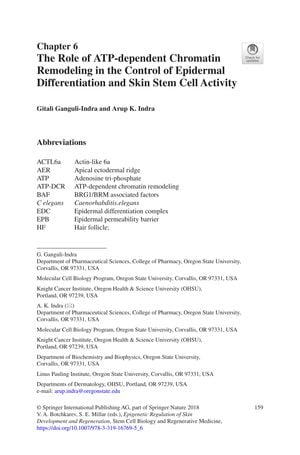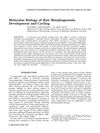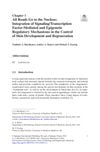The Role of ATP-Dependent Chromatin Remodeling in the Control of Epidermal Differentiation and Skin Stem Cell Activity
January 2018
in “
Stem cell biology and regenerative medicine
”
ATP-dependent chromatin remodeling epidermal differentiation skin stem cell activity hair follicle development wound healing SWI2/SNF2 family BRG1 BRM ATPases keratinocyte differentiation ACTL6a KLF4 Mi-2ß/CHD4 barrier formation p63 MAF:MAFB lncRNAs TINCR lncRNAs ANCR epidermal differentiation complex EDC locus hair regeneration chromatin remodeling skin pathophysiology tumor suppressors ATP-DCR BRM Mi-2ß CHD4 MAF MAFB TINCR ANCR EDC

TLDR ATP-dependent chromatin remodeling is crucial for skin development and stem cell function.
The 2018 document details the critical role of ATP-dependent chromatin remodeling (ATP-DCR) in skin biology, particularly in epidermal differentiation, skin stem cell activity, hair follicle development, and wound healing. It emphasizes the significance of the SWI2/SNF2 family, especially BRG1 and BRM ATPases, in the regulation of gene expression during skin development. BRG1 is highlighted as essential for limb patterning and keratinocyte differentiation, with BRM able to partially compensate for BRG1's functions. ACTL6a, part of the SWI/SNF complex, is shown to inhibit differentiation by repressing KLF4, and its loss leads to premature differentiation and thinner epidermis. The document also discusses the role of other chromatin remodelers like Mi-2ß/CHD4 in barrier formation and hair follicle development, as studied in mice. Furthermore, it discusses the orchestration of epidermal differentiation complex (EDC) locus relocation by p63 and the involvement of transcription factors MAF:MAFB, regulated by lncRNAs TINCR and ANCR, in epidermal differentiation. The deletion of Brg1 in mice results in impaired hair growth and hair loss, indicating its importance in hair regeneration. The document also touches on the implications of chromatin remodeling in skin pathophysiology and cancer, suggesting BRM and BRG1 may act as tumor suppressors. The conclusion calls for further research to understand the specific targeting of BRG1, its interactions with transcription factors, and the roles of other chromatin remodelers in maintaining skin stem cell identity and lineage.








